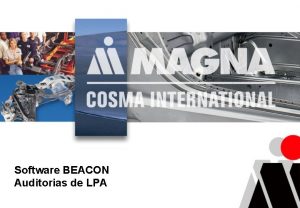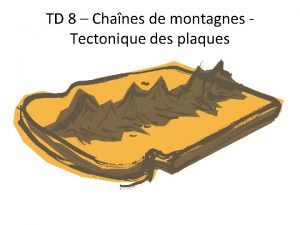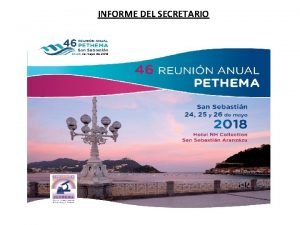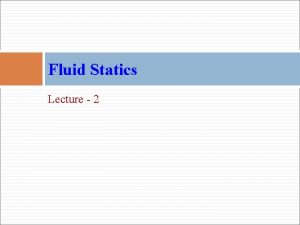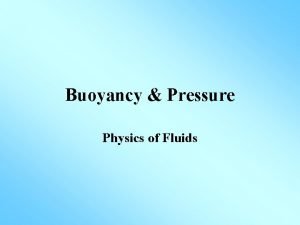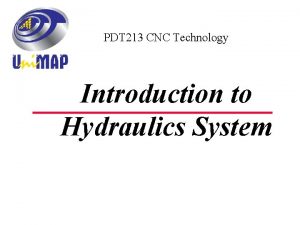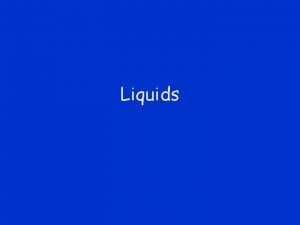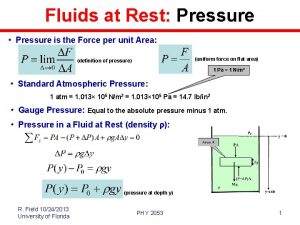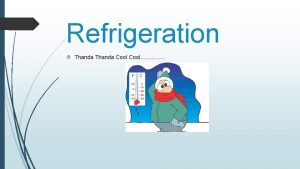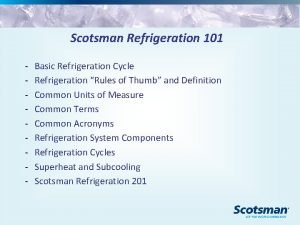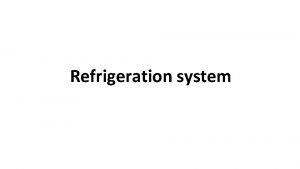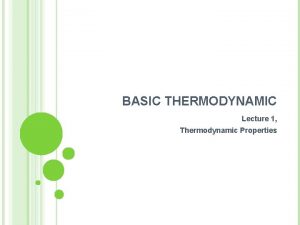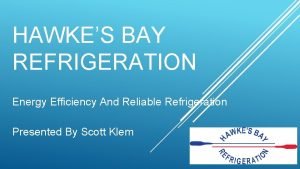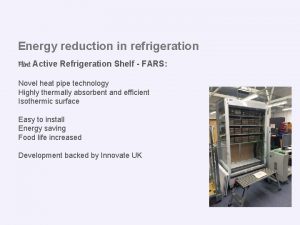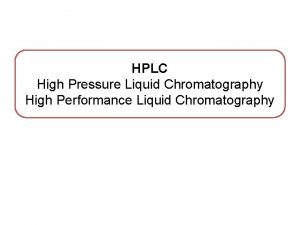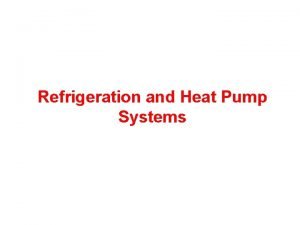LPA Refrigeration Thermodynamic Principles Liquid Pressure Amplification Energy














- Slides: 14

LPA® Refrigeration Thermodynamic Principles Liquid Pressure Amplification Energy Efficient Refrigeration Tomorrow’s Refrigeration Technology Today

LPA® Refrigeration How it Works The LPA® works by boosting liquid refrigerant through the refrigeration system. By increasing the liquid’s pressure, the associated saturation temperature is raised, while the liquid temperature remains the same. The liquid becomes subcooled – reducing the potential for flashing prior to the expansion valve. With LPA®, your business will enjoy higher efficiencies, lower power draws and substantial cost savings. Tomorrow’s Refrigeration Technology Today Est. 1984

LPA® Refrigeration Standard System If you were given the choice of paying 1. 14 kwh per ton of cooling or paying for only. 57 kwh per ton, which would you choose? Now you have that option. For years, the refrigeration industry has been taught the necessity of operating systems with high head pressures. Indeed, in the past, if the head pressure was lowered on a system, the cooling effect of the evaporator did diminish. Tomorrow’s Refrigeration Technology Today Est. 1984

LPA® Refrigeration Standard System However, high head pressure increases the amount of work the compressor has to do. And increased work, results in higher power bills and more frequent repairs. Removing the head pressure controls sounds like a wonderful idea, if you can maintain cooling efficiency. The problem is, as head pressure decreases, flash gas in the system increases. Tomorrow’s Refrigeration Technology Today Est. 1984

LPA® Refrigeration Flash Gas With the increase in flash gas, the evaporator loses capacity, and oil return to the system is no longer reliable. The life of the equipment may be greatly shortened. Consider a R 404 a system, with an eight psi drop in the liquid line. At 32°C condensing, flash gas is only 2% by weight. At these higher pressures the bubbles are compressed and present little problem. But if we lower the condensing temperature to 15°C, the flash gas will occupy 34% of the liquid line volume. Tomorrow’s Refrigeration Technology Today Est. 1984

LPA® Refrigeration Flash Gas What do we do with this excess flash gas? We could use a large expansion valve and let it pass through. If we do this, then a portion of the evaporator is filled with vapour that has no refrigeration effect. The compressor then has to compress this gas that it has already compressed once. In short, we have to de-rate the compressor and the evaporator. The ideal solution would be to prevent the formation of flash gas. Tomorrow’s Refrigeration Technology Today Est. 1984

LPA® Refrigeration LPA® System The LPA system does just that. The simplicity of the system is what makes it unique. A small, magnetically-driven refrigerant pump is inserted in the liquid line. The pressure of the liquid is increased 8 to 25 psi, above the flash point. The refrigerant cannot vaporise until it passes through the expansion valve. This is now the ideal system. Tomorrow’s Refrigeration Technology Today Est. 1984

LPA® Refrigeration Energy Savings A one-ton, R-404 a system at -9°C will consume 1. 14 kwh at 37°C condensing. At 15°C condensing, it will consume only. 57 kwh. This system may be applied to any refrigeration, air conditioning or thermal storage system using an expansion valve. The equipment can be installed at the factory by manufacturers or it may be installed as a retrofit. Tomorrow’s Refrigeration Technology Today Est. 1984

LPA® Refrigeration In a Nut Shell… “It is well documented that reduced discharge pressures and the corresponding reduction in compression ratios are beneficial both in terms of system longevity as well as reduced operating costs. The addition of the LPA® system will help to accomplish both these goals” Typical energy savings 20 to 45% (based on 10°C 50 F average mean ambient temperatures) Manufactured in accordance with the PED DIR/97/23/EC “CE” CAT A 1 – Gas Groups 1 & 2 UL Listed and Certified Mechanical Life Wet-End +20 Years Mechanical Life Impeller +100, 000 Hours Mechanical Endurance +300, 000 Cycles Mechanical Life Motor 12 to 15 Years Warranty – 7 Years The End- please continue on to references… (many more on request) Tomorrow’s Refrigeration Technology Today Est. 1984

LPA® Refrigeration References “I am writing to express my experience and confidence in the LPA® Liquid Pressure Amplifier technology you provide. ” “We demand that any technology we install on a performance contract be proven and reliable. The LPA®, when properly applied and installed, meets those criteria. Honeywell has installed LPA® projects all over the country. It has our confidence. “ “You frequently identify problems with the air conditioning equipment beyond your scope of work. These suggestions have greatly benefited both Honeywell and our customers. ” “As a result of your product and knowledge, Honeywell recommends LPA® technology as a good effective energy saving project. ” Kevin K. Mc. Kenzie, P. E. Professional Engineer Performance Contract Engineer Tomorrow’s Refrigeration Technology Today Est. 1984

LPA® Refrigeration References "With respect to floating head pressure, there is no adverse effect on reliability when pressure is reduced below 32°C. In fact, reducing the condensing pressure reduces the compression ratio and generally has a positive effect on both energy consumption and life expectancy. The LPA® will not conflict with Copeland Warranty. ” Richard E. Turner Copeland Corporation Refrigeration Technical Support Tomorrow’s Refrigeration Technology Today Est. 1984

LPA® Refrigeration References “This is to advise that Liebert's standard warranty would not be violated when the system is equipped with the LPA® Liquid Pressure Amplifier, provided the pump is installed in accordance with installation recommendations provided by the manufacturer. ” David F. Planitzer Liebert Corporation Heat Transfer Products Tomorrow’s Refrigeration Technology Today Est. 1984

LPA® Refrigeration References “The addition of the LPA® pump to the systems that we are building for you will have no impact whatsoever on our standard product warranty. ” “It is well documented that reduced discharge pressures and the corresponding reduction of compression ratios are beneficial both in terms of system longevity as well as reduced operating costs. The addition of the LPA® to our systems should help to accomplish both of these goals” Bob Mc. Donough Larkin Coils Applied Products Division Tomorrow’s Refrigeration Technology Today Est. 1984

LPA® Refrigeration In ending… Thank you for viewing hysave. com LPA® is a simple, reliable means of converting a refrigeration system to floating head operation, which is the efficient operation obtained by allowing the condenser to operate at lower pressure and temperature when ambient conditions permit. "To endorse LPA® (by some equipment manufacturers. ) is to acknowledge that one's equipment is not as efficient as it could be. Approval of LPA® by component manufacturers is well documented. Since large package equipment manufacturers exercise considerable control over the flow of information, the user acceptance and application concerns we have encountered are not surprising. “ “Annual energy savings typically range from 10 to 30% and paybacks of under two years are usually realized. “ Federal Technology Alert Federal Energy Management Program DOD, EPA, DOE # RVI 1295 Tomorrow’s Refrigeration Technology Today Est. 1984
 Liquid pressure amplification
Liquid pressure amplification Auditorias lpa
Auditorias lpa Lapisan jalan raya
Lapisan jalan raya Staurotide lpa
Staurotide lpa Lpa certification
Lpa certification Protocolo pethema lpa 2017
Protocolo pethema lpa 2017 Heating preservation
Heating preservation Example of pure liquid dielectric is
Example of pure liquid dielectric is Triangular diagram for liquid-liquid extraction
Triangular diagram for liquid-liquid extraction Definisi tekanan zat padat
Definisi tekanan zat padat Examples of fluid statics
Examples of fluid statics Calculating buoyant force
Calculating buoyant force Pascal law for pressure of liquid
Pascal law for pressure of liquid Properties of liquid pressure
Properties of liquid pressure Fluids at rest
Fluids at rest

